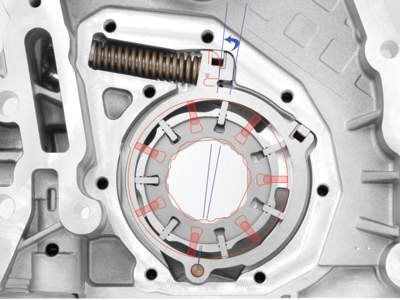No, that's not how that oil pump works. It's not a computer fan.
yes it does, actuator with pwm control varies the volume being pumped to meet a pressure target. No matter how you dress it up, that's what it does.
https://www.underhoodservice.com/variable-displacement-future-oil-pump/
Pump
Almost every variable displacement oil pump application is mounted on the crankshaft. This placement eliminates the need for an intermediary shaft that can fail.
Variable displacement pumps are “gerotor” designs. Gerotor pumps have trochoid gears that allow for smooth operation, low noise and excellent suction. The centrically seated drive gear drives an external eccentrically seated annular gear. The result of which is cavities inside the pump compress and enlarge to create the suction and feed effect.
The inner rotor sits on the crankshaft and drives the outer rotor. Since the inner and outer rotors have different rotating axes, more space is created on the suction side due to the rotating motion. The oil is drawn in and transported to the pressure side. On the pressure side, the space between the gears’ teeth becomes smaller again, and oil is forced into the oil circuit under pressure.
A variable displacement oil pump changes the rotating axis of the outer gear. To achieve this, the gears of the inner rotor are replaced with variable-length vanes. The outer gear pivots on an axis; opposite the pivot is an electronic actuator. On mechanical versions, a spring replaces the actuator and the opposite side of the housing has oil or a piston that pushes against the spring to regulate pressure.
Actuator
Most variable displacement oil pumps use an electric solenoid to change the axis and eccentricity of the pump housing, and position is determined by the ECM. Changing the geometry of the housing changes the amount of pressure and volume of the pump. Most actuators use a pulse width modulated signal to control the position of the actuator, and some scan tools can display the PID for the actuator position.

Last edited:

